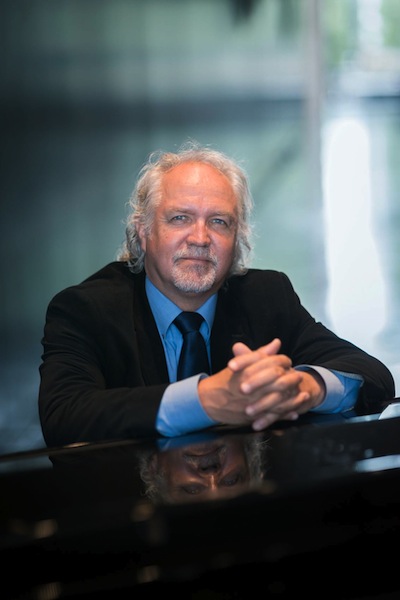Runnicles, DSO find compelling common ground with Mozart, Mahler

Donald Runnicles conducted the Dallas Symphony Orchestra in music of Mozart and Mahler Thursday night. Photo: Simon Pauly
Mozart and Mahler made an intriguing pairing in the Dallas Symphony Orchestra’s first classical concert of the year Thursday night at Meyerson Symphony Center, with guest conductor Donald Runnicles on the podium.
Mozart’s “Prague” symphony (No. 38) and Mahler’s Das Lied von der Erde (The Song of the Earth) were born 120 years apart, and the differences in style are obvious. But the two works fall on the same linear pathway of the Viennese symphonic tradition, and their juxtaposition in this concert provided a unique and intriguing view of two of towering geniuses of that tradition.
Mozart’s symphony opens with five stubborn forte D major chords; Runnicles (probably the only left-handed conductor in the business) gently guided the extended Adagio introduction forward with a touch of rubato, drawing a passionate swell of the strings and an irresistible sense of pulsating energy in the main Allegro. The orchestra, with a slightly reduced string section, responded to Runnicles with a lucid but substantial tone appropriate for the presentation of Mozart’s orchestral music in a large concert hall. That tone, combined with Runnicles’ broad, lyrical, phrasing, was particularly appealing in the Andante movement, a sunny, fluid quasi-minuet.
Runnicles likewise skillfully managed the constant mood-changes of the Presto Finale; the rapid intertwining of varied emotions created, under the conductor’s skillful direction, an aura comparable to the sense of joy and humanity one experiences in the closing scenes of Mozart’s operas.
Mahler’s Das Lied von der Erde represents the culmination and ultimate combination of two genres: the song cycle and the romantic symphony. A set of German translations of ancient Chinese poetry provides the text of the six monumental “songs”; the gorgeously descriptive poetry inspired numerous delicate instrumental effects, even though Mahler called for a characteristically large orchestra. The orchestra performed with impressive precision throughout.
Tenor Russell Thomas, renowned for performances of the great Verdian roles, demonstrated an impressive and unfailingly powerful range, handily nailing the climactic high B in the opening movement, “Das Trinklied vom Jammer der Erde” (“The Drinking Song of Earth’s Sorrows”). However, he largely failed to bring a sense of convincing personality—or, for that matter, dynamic range, as he largely remained in a zone from forte upward.
For her part, mezzo-soprano Kelley O’Connor, displayed considerable flexibility with a rich, somewhat dark timbre, well suited for the second movement, “Der Einsame im Herbst” (“The Lonely Man in Autumn”). In one section of this movement, a flowing motif in the strings (beautifully executed in this performance), echoes the Andante of Mozart’s Symphony No. 38; the overall effect was of sorrow transformed into gorgeous music.
In “Der Jugend” (“Of Youth”), the first of the work’s central pair of (relatively) brief movements, tenor Thomas began to find a deeper sense of subtlety in this description of carefree young people. In the subsequent “Von der Schonheit” (“Of Beauty”), the mezzo-soprano describes a group of young women gathering flowers while a troupe of young men on horses approaches, inspiring some of Mahler’s most sensuous orchestration; unfortunately, Runnicles allowed the orchestra to drown out O’Connor at one of the louder moments in the movement. In the second tenor drinking song, “Der Trunkene im Frühling” (“The Drunk in Springtime”), Thomas continued his aggressive approach in this lively description of hedonism as a response to hopelessness.
At half an hour, the final movement, .“Der Abschied” (“The Farewell”), is longer than Mozart’s entire “Prague” symphony. This sorrowful epic movement features the mezzo-soprano as soloist, but the extended orchestral interludes make it almost an independent tone poem. O’Connor, Runnicles, and the orchestra collaborated to produce a perfect Mahlerian moment—lavish in delicate colors and intense emotion.
O’Connor’s calmly mournful delivery of her first phrase, gently intertwined with flute solo, created a breathtaking aura of desolation, preparing the ensuing emotional journey. Pacing is challenging and utterly essential here; Runnicles once again guided the assembled forces through the numerous exposed solos and those tricky moments of absolute silence.
All of this aimed toward the final apotheosis and reconciliation in glorious C major, with O’Connor delivering the radiant phrase with perfect control, as it faded toward the final “Ewig” against a backdrop of harps and celeste.
The program will be repeated 7:30 p.m. Friday and 2:30 p.m. Sunday at Meyerson Symphony Center. mydso.com; 214-602-0203.



Posted Jan 12, 2019 at 1:54 am by Cal Lewiston
A thoroughly enjoyable and satisfying musical performance, indeed!